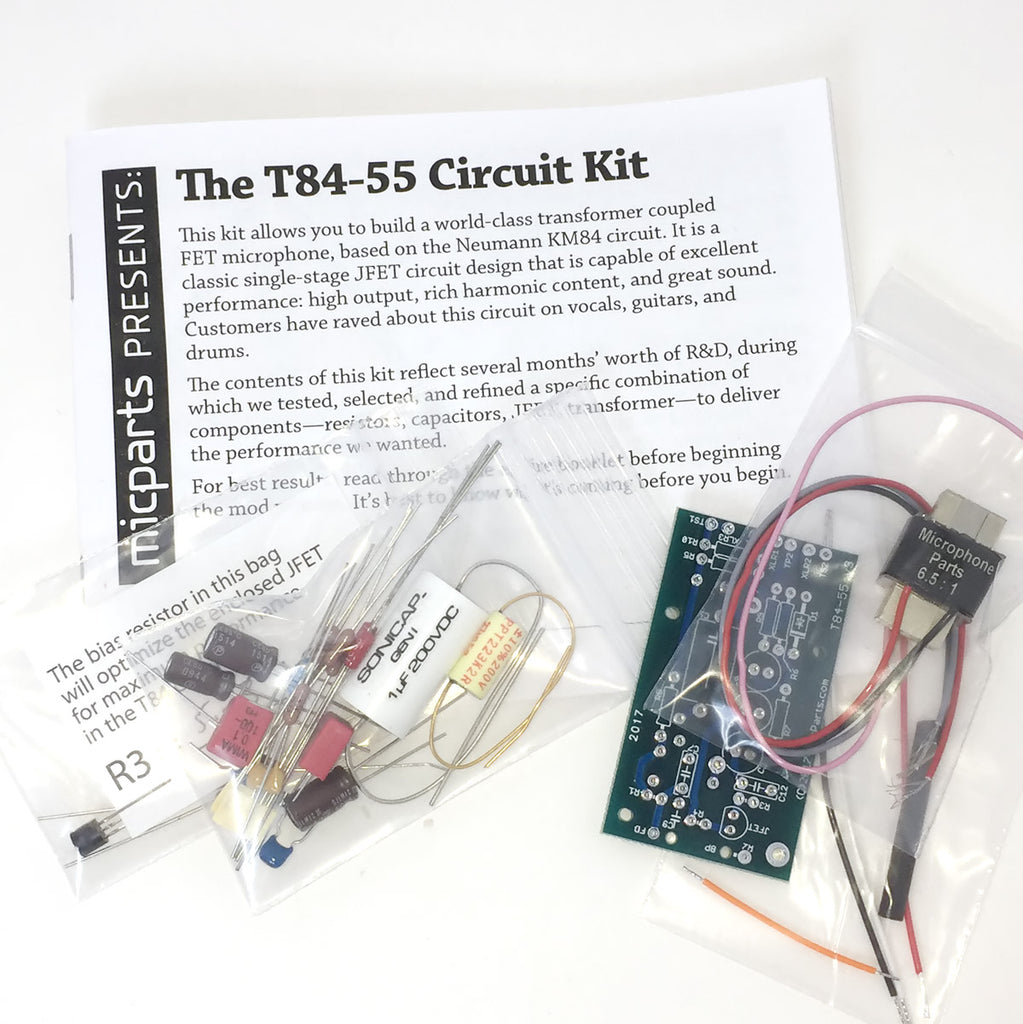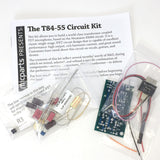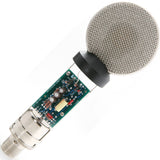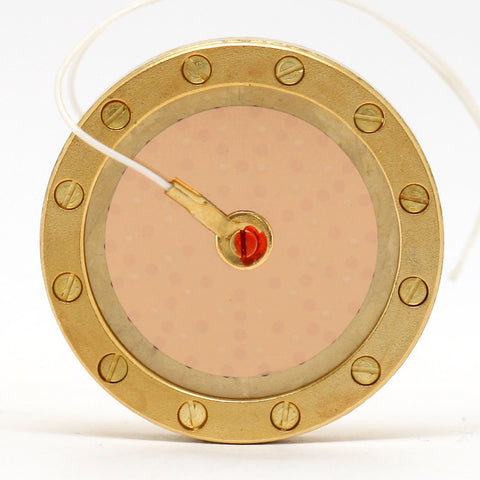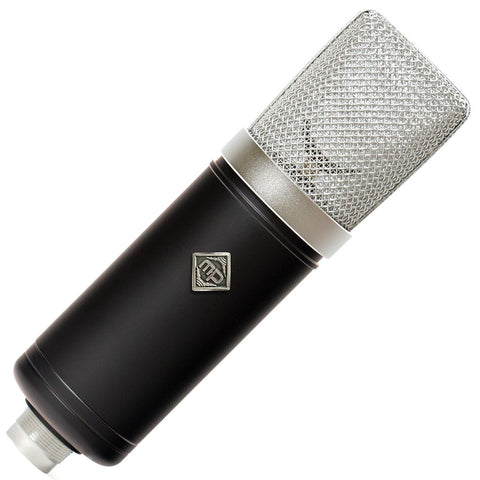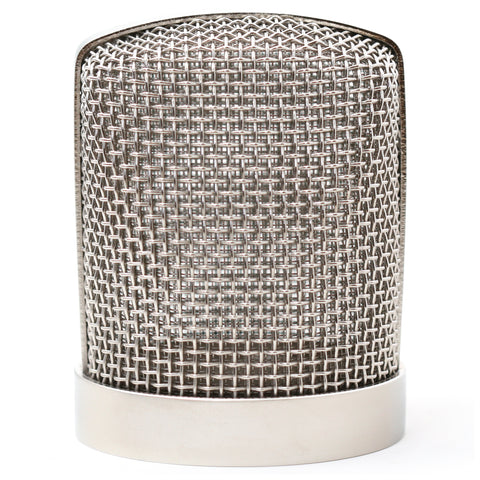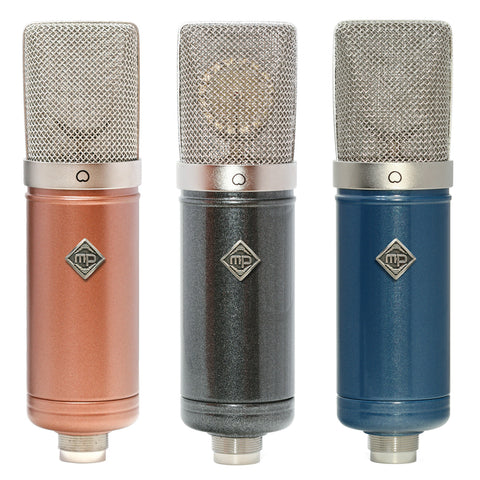T84-55 Circuit Kit
$ 229.00
The T84-55 is a premium transformer-coupled microphone circuit kit, designed as a drop-in upgrade for popular donor microphones from Groove Tubes, Sterling Audio, and M Audio.
The circuit design is similar to what you'd find in high-end microphones such as the Mojave Audio MA-201/MA-301 FET. Read more about the genesis of this circuit design on the T-84 Circuit Kit page.
Why upgrade the circuit?
Although the stock circuit in these microphones is not deeply flawed, it leaves room for improvement. Compared to the original circuit, the T84-55 offers:
- 3–8dB higher output (the sensitivity of the various Luna, ST55, and GT55 mics we measured varies by 5dB, but the T84-55 has higher output than all of them)
- 8dB lower self-noise
- higher levels of second harmonic content
The last point above is the critical one. Vintage microphones sound the way they do in part due to 2nd harmonic distortion. Modern transformerless electronics lack this sound. People who use the words "warm" and "vintage" when describing a microphone (or preamp, or outboard gear) are often trying to describe the sound of harmonic coloration.
It is not true that any transformer, or any tube circuit, will create musically useful harmonics. The T84-55 will, because we designed it to.
Differences between T-84 and T84-55
The "T-84" was our original implementation of the Neumann KM84 circuit, adapted for large-diaphragm capsules. It was our first JFET/transformer topology circuit kit, and quickly became a best-seller. The "T84-55" is a re-imagination of this circuit, incorporating the following changes:
- The T84-55 fits the GT55, ST55, ST51, Luna, and similar microphones.
- The T84-55 supports external pad and filter switches found on the GT55 and ST55.
- The T84-55 uses a different complement of capacitors than does our T-84, to serve the goal of creating diversity in your mic locker.
- The T84-55 does not employ the "negative feedback" design of the original KM84 circuit or our T-84 implementation of same. As a result, the T84-55 has higher output and higher harmonic coloration than the T-84.
- The T84-55 contains subtly less low-frequency filtering (-3dB @ 10Hz, rather than 30Hz like the T-84).
- The T84-55 is offered with or without our custom-wound transformer. If you'd like to experiment with alternative output transformers, you can (but see the notes below).
Compatibility
The T84-55 circuit board is known to fit:
- Groove Tubes GT55
- Sterling Audio ST55
- M-Audio Luna
We believe it will also fit:
- M-Audio Luna II
- M-Audio Nova
- Sterling Audio ST51
Although the PCB will fit the ST59, it will not support the 3-way polar pattern switch in that microphone. Therefore we do not recommend this kit for the ST59.
If you hope to retrofit the T84-55 circuit into a different donor mic, click the drawing above to download a scaled PDF of the PCB dimensions and mounting holes. Check the size of the hardcopy against the dimensions printed on the page to ensure that your printer has not scaled the diagram up or down.
Pristine, vintage signal path
Capsule → JFET → output capacitor → transformer. That is the entire signal path.
The circuit has no input capacitor. The only capacitor directly in the audio path is the output cap, which is either a high-grade, US-made metallized polypropylene part from Sonic Craft, or (when the HPF is engaged) a film-and-foil polypropylene part. Note that the HPF cap is not paralleled across the output cap; only one of these two output caps is active at a time.
Transformer Options
The MP6.5 transformer option provides excellent performance: flat frequency response (within 1dB) from 20Hz–20kHz, with a musically appropriate level of 2nd harmonic distortion. 3rd harmonic distortion (the bad kind) is 10dB lower than 2nd harmonic.
 Our T-84 implementation, which incorporates this transformer, has received rave reviews.
Our T-84 implementation, which incorporates this transformer, has received rave reviews.
We also offer the T6.5 transformer, which offers nearly identical (and flat) frequency response performance from 20 Hz-30kHz. It has the same turns ratio and output level as the MP 6.5:1 transformer. It offers 2dB more second harmonic content than the MP 6.5:1 transformer.
We have tested a handful of popular alternatives to guide DIY experimentation. (Pictured above is the test rig we built for transformer testing. We injected a swept sine wave into the input circuit and plotted the resulting frequency and distortion performance.)
If the following discussion is overwhelming, we strongly recommend choosing the MP6.5 transformer. All the circuit R&D work was done with our transformer; it delivers field-proven performance at a great price, and is the easiest of all these options to install.
If you choose a transformer we have not tested, be aware that your results might be unexpectedly bad. See the first transformer below as an example.

GT/Sterling/M-Audio Transformer
The stock transformer in the ST55/GT55/Luna/etc is not appropriate for T84-55 circuit. We measured and heard a surprisingly strong low-pass filter effect from this transformer when used with our circuit: e.g., -10dB @ 10kHz. See the purple trace in the graph above.
If you re-use the GT/Sterling transformer with the T84-55 circuit, your microphone will be unpleasantly dull and dark sounding, even with a bright capsule.
(FWIW, the GT/Sterling transformer does not create the same filter effect in the GT/Sterling circuit.)
AMI T8
The AMI T8 ($120) has a 7:1 turns ratio. Its output is about 0.6dB lower than the MicParts transformer. It imparts a mild HPF effect (-3dB @ 20Hz) with a minor but unexpected lift in the top two octaves (+0.5dB @ 10kHz). See the blue trace in the graph above.
The T8 has 2-3dB higher 2nd harmonic distortion than the MicParts transformer, and a bit more than that below 200Hz. Coupled to the mild HPF effect, the T8 would give the mic a good amount of coloration when used as a close mic, but maybe too much for moderate-to-high SPL sources.
We don't love the thin hookup wire used on the T8; it seems unnecessarily fragile. Also, the wire pairs are not distinguished by color, making it easy to wire the transformer with an unintentional polarity reversal.
Bottom line: the T8 works well with this circuit, if vocal recording is the primary intended application. But it is pricey, and a bit more delicate to install.
Cinemag CM-5722
The Cinemag 5722 ($75) is a BV-107 recreation, making it a fine choice for a KM84 style circuit. The turns ratio of 6.9:1 is appropriate for this circuit. The transformer's frequency response when used with the T84-55 is essentially flat (and within a quarter-dB of the MicParts transformer from 20–20kHz). The output level is 0.3dB lower than the MicParts transformer.
The CM-5722 has 2-3dB lower second harmonic distortion than the MicParts transformer from 70Hz–20kHz, giving this transformer slightly less harmonic coloration.
The only caveat is that it has 8 wires, in addition to copper foil for grounding the lamination; those extra wires and foil make installation somewhat more difficult.
Cinemag CM-13113
The Cinemag 13113 ($60) is a higher-ratio transformer, 9.5:1, often used in U87i builds. it has 2dB lower output than the MicParts transformer. Its second harmonic distortion is 10dB lower than the MicParts transformer, so it gives a cleaner sound, with less coloration. 3rd harmonic distortion is the same as the MicParts transformer. The frequency response is essentially flat.
Bottom line: this transformer works well with the T84-55 circuit, and yields performance very similar to the original T-84 design.
Jensen JT-DB-EU
We're not sure this part is actually made any more. We tested it because we had one in the parts bin. An alternative package called the JT-DB-E can be purchased, but comes in a Mu-metal can that might not physically fit your donor microphone.
Despite Jensen's presentation of this as a "direct box transformer," we found that it works well with our circuit. Its ratio is 12:1, higher than this circuit needs, but it delivers very flat frequency response and low distortion characteristics with the T84-55 circuit.
The drawbacks, in addition to the fact that we're not sure this transformer is actually made any more, are that the higher turns ratio lowers output level by 3.5dB, and the 2nd harmonic level is lower than 3rd, which runs counter to the design philosophy of this circuit (namely, to provide musically useful levels of transformer coloration at moderate SPL).
Included with the T84-55 kit
- Custom, US-made, 2-layer circuit board
- Your choice of two transformers, or no transformer at all
- 100% of necessary components to build the new circuit
- Parts and instructions for supporting the donor mic's HPF and pad switches
- Comprehensive, step-by-step DIY instruction guide
- Tech support via email
Skill Level
This circuit kit is slightly trickier to build than the T-84, both because we put components on both sides of the T84-55 board, and because switches always add 50% to the build time and complexity of any microphone circuit.
If you've never built a microphone circuit before, we would recommend starting with something easier. See this FAQ.
Capsule Options
The "disk resonator" capsule found in the GT55 and ST55 provides a somewhat unique sound. It has good bass response, and two presence peaks: about +3dB at 4500Hz, and +5dB at 11kHz. It works well on some sources, but probably sounds too bright/hyped on others.
The new circuit won't change the frequency response of the capsule, so if you find the mic to be too bright or hyped before the circuit mod, you'll want to change the capsule too.
Installing a new capsule in the M Audio Luna and Luna II is relatively straightforward.
The GT55, ST55, ST51, and similar microphones present a challenge, because the neck of the grille is barely 34mm wide. See the tutorial for capsule replacement on the GT55 or ST55. (The ST51 requires the same procedure.)

